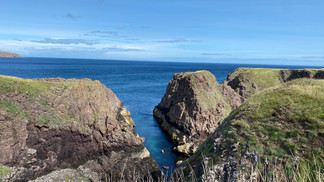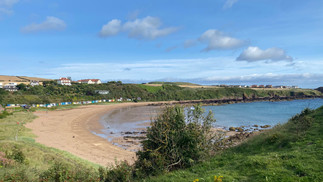The Soothing Blue Sky: A Balm for Mental Health
- aarondowds

- Aug 22, 2023
- 3 min read

When we gaze up at the sky on a clear day, we're often greeted by a vast expanse of blue that stretches as far as the eye can see. The serene blue hue has a subtle yet profound impact on our mental health, acting as a natural balm that soothes our minds and uplifts our spirits. In this blog, we delve into the science behind why the blue color of the sky is beneficial to our mental well-being.
1. Evolutionary Connection for Blue Sky Mental Health Effect
From an evolutionary perspective, humans have spent the majority of their existence outdoors. Our ancestors relied on the sky's color to gauge weather conditions, predict changes, and understand their environment. The blue sky often indicated calm and fair weather, which allowed our ancestors to engage in outdoor activities, gather resources, and build communities. As a result, our brains have developed an innate positive association with the color blue, triggering feelings of safety and tranquility.

2. Colour Psychology
Color psychology suggests that different colors can evoke specific emotional responses. Blue is often associated with feelings of calmness, relaxation, and tranquility. When we look up at the blue sky, these feelings are automatically triggered in our brains, promoting a sense of peace and reducing stress and anxiety. The color's cool and soothing nature helps to slow down our thoughts, enabling us to experience a moment of respite from the hustle and bustle of our daily lives.

3. Biological Impact
The blue color of the sky also has a direct impact on our body's physiological responses. Exposure to blue light stimulates the production of serotonin, often referred to as the "feel-good hormone." This neurotransmitter plays a crucial role in regulating mood, appetite, and sleep patterns. Increased serotonin levels lead to improved mood, reduced feelings of depression, and enhanced overall mental well-being.

4. Nature's Canvas
Nature itself is a powerful tool for enhancing mental health, and the blue sky is an integral part of this natural experience. The combination of the blue sky, the gentle movement of clouds, and the warmth of the sun creates a sensory experience that is deeply soothing. This natural setting provides an opportunity for mindfulness, allowing us to be present in the moment and find solace in the beauty around us.

5. Symbolism of Infinite Possibility
The vastness of the blue sky also holds symbolic significance that can positively influence our mental state. The infinite expanse of the sky represents endless possibilities and the potential for growth and change. When we contemplate the boundless nature of the sky, we are reminded that our problems and worries are just a small part of a much larger world, putting things into perspective and reducing feelings of overwhelm.
📍St Abb's to Eyemouth Coastal Path with Dad and a swim in the Ocean
In conclusion, the blue colour of the sky is an intelligent design from an intelligent designer and not merely a visual phenomenon; it's a powerful contributor to our mental health and well-being. Whether through its evolutionary connection, color psychology, biological impact, or symbolism, the blue sky offers us a natural remedy for stress, anxiety, and the challenges of modern life. So, the next time you find yourself needing a moment of tranquility, take a step outside and let the soothing blue sky work its magic on your mind.
3 Cracking routes to try out for you:
St Abb's Head, St Abbs "St Abb's Head is a dramatic coastal headland, ringed by cliffs and famed for its seabird colonies. This walk takes you around the Mire Loch and up around the cliffs of the Head, a National Nature Reserve. It is a straightforward route and provides good views of the highly populated bird nesting areas and a lighthouse that has been in service since 1862. There is a tea room and toilets adjacent to the car park."
Dunbar cliff top trail, Dunbar. "This circuit from Dunbar is in two parts - the first explores the red sandstone cliffs and golf courses and the second the historic high street and and harbours. Dunbar was the childhood home of the father of the conservation movement - John Muir - and his birthplace is now a museum."
Berwickshire Coast Path 3: St Abbs to Eyemouth. "The third stage of the Berwickshire coastal path runs from the attractive fishing village of St Abbs along the clifftops and beaches to reach Eyemouth."






















Comments